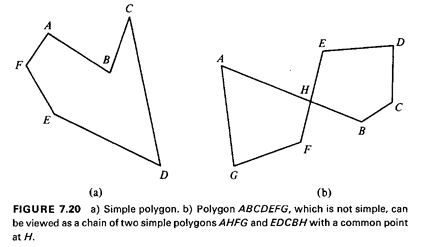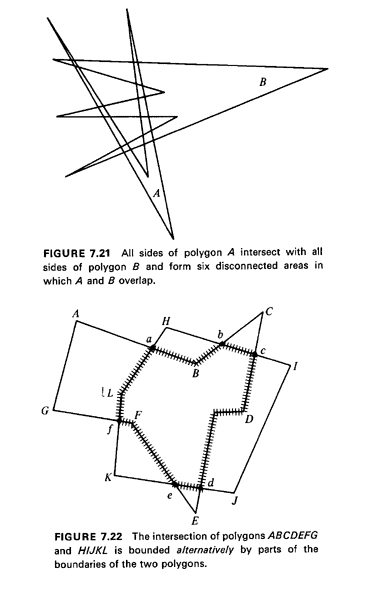


7.2.5 Intersections of Reporting ZonesWe can now turn our attention to some of the more difficult questions that we have asked in the beginning of this section, such as: "Which ambulance zones have areas in common with a particular police precinct?" In general, we shall deal next with questions involving intersections of polygons. From our earlier assumption that all elementary reporting zones in a city can be represented as polygons (with arbitrary numbers of sides) it follows that such entities as "districts," "precincts," "ZIP-code areas," and so on, which are combinations of one or more reporting zones, can also be represented as polygons (with no special properties such as convexity). The efficient "intersections algorithm" (Algorithm 7. 1) which we discussed in Section 7.2.4 and the point-polygon method will be particularly useful in answering questions related to polygons. It will be assumed below that all geographical entities under
consideration are simple polygons. A simple polygon is one that has no
intersecting sides (see Figure 7.20a). It is easy to check whether this
condition is satisfied by using Algorithm 7.1. For an n-sided polygon,
each side is viewed as a line segment and Algorithm 7.1 is applied. If
no intersections are discovered, the polygon is simple. If it is not,
the polygon can be viewed as a chain of two or more simple polygons,
with neighboring polygons in the chain having only a finite number of
corner points in common (Figure 7.20b). Each simple polygon in the chain
can then be treated separately. Thus, the assumption that all
geographical entities are simple polygons is not restrictive.

An important issue now is deciding whether two simple polygons A and B overlap.8 For this to happen, either some sides of A must intersect some sides of B, or A must be wholly contained in B (or vice versa). The following procedure then suggests itself. We shall assume, without loss of generality, that polygons A and B are both n-sided.
Since in Step 1 we have 2n line segments, and thus 4n end points, the time required is O(n log2 n). The point-polygon method (and Step 2) is O(n). It follows that it is possible to decide whether two n-sided polygons (or reporting zones, districts, etc.) overlap in O(n log2 n) time. We can now answer the question which we posed earlier. To find which ambulance zones have areas in common with a particular police precinct, we apply the procedure described above k times (where k is the number of candidate ambulance zones), once for each ambulance zone. If both the police precinct and the ambulance zones are n-sided polygons, this question can be answered in O(kn log2 n) time. So far we have been able to check whether zones overlap with each other
and, if so, to identify the pairs of zones that overlap, as well as
whether the overlap is partial or if one zone is fully included in
another (and which one). It is also possible to identify the polygon
that forms the intersection of two overlapping zones (i.e., to have the
computer "draw" this intersection for us). Unfortunately, however, there
are no shortcuts for doing this faster than the
straightforward method: since, in the worst case, each side of polygon A
will intersect every side of B (and vice versa), there will be a total
of n2 intersections (if A and B are n-sided polygons), and therefore
the computational effort must also be at least O(n2)- see also Figure
7.21. It should be noted that the boundary of the polygon that describes
the intersection of two polygons A and B consists of a part of the
boundary of polygon A, followed
by a point where a side of A intersects with a side of B, followed by a
part of the boundary of B, followed by an intersection point of the
boundaries,
followed by a part of the boundary of A, and so on (see Figure 7.22).
This, of course, assumes that A is not fully contained in B, or vice
versa.

8 We shall adopt the convention that if two polygons have only corner points and (possibly) sides in common, they do not overlap. Clearly, this convention could be modified, when necessary. 9 A special procedure must be followed whenever this intersection happens to coincide with a comer point of the polygons. |


